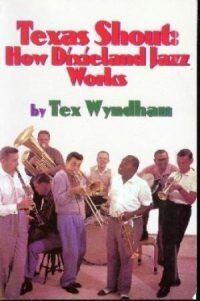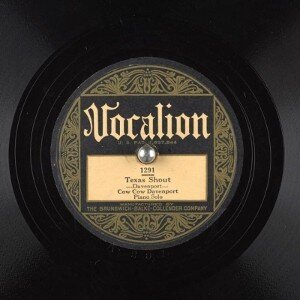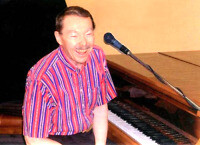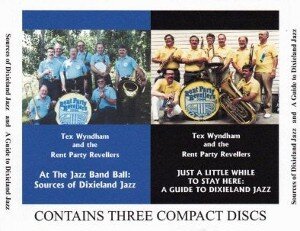Set forth below is the twenty-fourth “Texas Shout” column. The concluding installment of a two-part essay, (PART 1 is HERE) it first appeared in the 1991 Holiday issue of the West Coast Rag, (now Syncopated Times.) The following note was added when the column was reprinted in the late 90s.
Since writing this essay, I have begun teaching a Road Scholar course on ragtime, early Tin Pan Alley and Dixieland jazz. In that course, I have found it useful to refer to the special rhythmic quality that defines jazz as “jazz time.” That is, jazz is music played in jazz time; if it is not played in jazz time, it isn’t jazz.
This may initially appear to be an empty and circular way to define jazz. However, it has two distinct advantages.
First, it focuses the listener on the fact that the defining characteristic of jazz relates to its rhythmic feeling. Second, it avoids the incorrect conclusion sometimes implied by the words “hot” and “swinging” — the common terms used in the jazz community to describe this quality — that jazz needs to be fast and/or loud to be “hot, swinging” music.
Anyway, the term “jazz time” works for me. I’ll pass it along to you for whatever help it may be in understanding a frequently elusive concept and also to orient you in the right direction for the following discussion.
One other minor introductory note. If I were writing the column today, I would add a few words to one sentence below to make it read as follows: Stride piano, in my view, together with novelty piano — stride’s white counterpart, is the most difficult non-classical style there is.
At this point, I had concluded that the distinguishing feature between ragtime and Dixieland jazz is that jazz is played with a certain urgent type of forward movement, known to Dixielanders as “hot” or “swinging” rhythm, while ragtime is not. My next move, in preparing for the ragtime-Dixieland seminar I was to conduct with Dick Zimmerman at Fresno’s West Coast Ragtime Festival, was to test that conclusion against the variety of music that would be heard at Fresno during that weekend.
Most of the music seemed to pass this test, but two types did not. Typically, at ragtime weekends, there is a certain amount of Jelly Roll Morton-style and Harlem stride piano played.
Unlike ragtime styles, stride and Morton have the forward movement I had identified as belonging to jazz. Although some ragtime authorities consider stride and Morton to be ragtime styles, my analysis was suggesting that these authorities are mistaken and that both are truly classifiable as jazz styles.
Liking both ragtime and Dixieland, including stride and Morton, I had never particularly given the subject of their precise categorization much thought. However, considering stride and Morton as jazz styles seemed to explain a few things.
First of all, that view is consistent with virtually all writing about jazz. To the best of my recollection, every comprehensive treatise I’ve seen that deals with pre-swing jazz but not with ragtime will include stride and Morton on the jazz side of the fence. It is only the authorities to try to deal with ragtime, or with ragtime and Dixieland, who express conflicting views on the topic.
Second, my observation is that ragtime buffs who do not like Dixieland jazz often do not care much for stride or for Morton, while Dixieland fans who say they don’t like ragtime usually do enjoy stride and Morton. If both stride and Morton actually are on the jazz side of the line, this divergence of opinions makes perfect sense.
There is another convincing argument telling us that stride and Morton are jazz and not ragtime. If you request a rendition of, say, “Carolina Shout” from a ragtime pianist who does not play jazz, the result will not sound like a Harlem stride number but will sound like a novelty rag. Conversely, if you want a Missouri Valley classic rag from a stride pianist who does not play the common ragtime styles, the result will swing (see, for example, Ralph Sutton’s wonderful 1949 Backroom Piano session — Verve MGV 1004). The stride pianist plays the notes on the score with jazz’s unique momentum, but the ragtimer does not give those same notes the same feeling.
If stride and Morton are not ragtime styles, why are they commonly heard at ragtime festivals? I can think of three reasons.
Many ragtime fans, like myself, also like Dixieland jazz. They’re perfectly happy to come to a “ragtime” weekend and listen to music they enjoy, even if it isn’t always strictly ragtime. We see the same thing at many of today’s “Dixieland” festivals where, as I have previously pointed out in these pages, some of the most popular bands are playing non-genre music, i.e., music which makes no claim to be Dixieland.
Further, stride and Morton came directly out of the ragtime years. There is a lot of ragtime that informs both styles. Despite the difference in rhythmic movement between ragtime and jazz, there is much in stride and Morton that a ragtimer will recognize and be comfortable with.
Third, most ragtimers are quick to appreciate a high level of technical keyboard accomplishment. Stride piano, in my view, is the most difficult non-classical piano style there is. For his part, Morton was one of the finest pianists of his day from the point of view of sheer keyboard mastery. A tickler who is able to execute a flawless rendition of “Carolina Shout” or “Shreveport Stomp” is, for that reason alone, sure to get attention, and a warm round of applause, from a room full of ragtime fans.
So far, I’d concluded that ragtime and jazz differ only in their rhythmic feeling, and that Harlem stride and Morton-style piano were properly classifiable as jazz and not as ragtime. Nothing extraordinary there. I’d merely clarified in my own mind a couple of points that are commonly made in jazz literature.
However, I wouldn’t let the subject alone. Having concluded that stride wasn’t ragtime, I decided to see what other differences there might be between stride and ragtime. That line of investigation produced a result that still surprises me.
Stride piano makes heavy use of riffs, i.e., short, repeated phrases that develop emotional intensity through repetition. As I began examining the common stride riffs — the licks that stride pianists most frequently toss in as fills while they’re thinking through their next moves — I realized, to my astonishment, that none of them are syncopated!
Take, for example, what is probably the most commonly-used stride fill, a right-hand four-note broken arpeggio. This figure plays the four notes in the following order: top note, next-to-the-top note, bottom note, next-to-the-bottom note. In 4/4 time, they are played as eighth notes. As explained below, the first note is struck a half-beat ahead of the downbeat. This lick is usually repeated a few times without a break, that is, it becomes a string of unsyncopated eighth notes.
Without taking you through a dry musical analysis of each riff, I could say the same about all of the other common stride licks, such as the triplet-based figure Fats Waller uses at the beginning of “Valentine Stomp” — they aren’t syncopated. However, they are all very “pushy.” That is, they all have a built-in drive that whips the music ahead.
A stride lick achieves this pushy effect because its first note is usually an eighth-note pickup that slams the lick into the downbeat. In fact, if you play the lick without this pickup, the treble line suddenly becomes stiff and unswinging.
By taking this reasoning to its logical extreme, a pianist could put together a stride chorus of hot licks that builds, is logically constructed, but is entirely unsyncopated. The conclusion to be derived from such an exercise, one that amazed me, is that it is not essential for jazz to be syncopated! As long as the notes are articulated using jazz’s unique forward motion, the music will be hot and will swing without regard to whether the lines happen to be syncopated at the time.
As far as I know, the notion of unsyncopated jazz has never before appeared in print. (I’ll probably get my head handed to me in future “Letter Drop” submissions for suggesting it.)
The conventional wisdom says that ragtime conditioned the general public to syncopated music and that jazz built on this foundation to incorporate much more sophisticated syncopation than ragtime has. It is certainly true that syncopation has always been part of the normal vocabulary of jazz; there was no reason for it to be otherwise, once syncopation had become so pervasive via ragtime’s popularity. Also, any time you have seven or so musicians improvising at once, you will encounter an extremely complex and sophisticated pattern of syncopation.
However, I now believe that, while such syncopations heighten the interest of jazz music, they are not a sine qua non of jazz. To draw an analogy: Whenever I have a hot dog, I always pile on catsup, mustard, relish, hot peppers, and (depending on the situation) maybe sauerkraut, chili and/or cheese. Those condiments add tang and spice to the meal. If I remove them, the hot dog will not be so flavorful, but it will still be a hot dog. So it is with jazz and syncopation.
One can see this distinction more clearly by studying the basic jazz piano style of the thirties, which typically includes lots of long unsyncopated eighth-note runs. When you listen to Teddy Wilson or Art Tatum play, and they go into these glistening runs, you don’t feel any sense of the performance becoming any less jazzy at those points. That’s because these artists continue to articulate the notes, syncopated or not, in a jazzy, swinging way.
When I told my lovely bride Nancy that I was going to write an article in which I would say that jazz does not need to be syncopated, she perceptively replied: “If you make such a radical statement, shouldn’t you be able to back it up by citing at least one jazz performance that isn’t syncopated?” That’s a tall order. As I mentioned above, there is no reason for jazzmen to try to avoid syncopation, especially when it adds so much flavor to the results.
However, Nancy came to my rescue by recalling what might just be the only album in our 5000-record collection that contains some unsyncopated jazz renditions. She remembered it because I had cited it (for another reason) in a review a few years ago, and the cite had prompted a letter to the editor from a reader who took strong issue with what I’d said about it. As a result, Nancy and I had discussed the philosophy of that record, and of my interpretation of it, a few times.
“George Lewis Plays Hymns” is one of the great clarinetist’s best and most beloved albums. It is a trio session in which, accompanied by bass and piano, Lewis plays unsyncopated sacred music, adding a few fills but without really attempting to improvise on most of the melodies.
I have always enjoyed it. Until recently, though, I believed that it did not qualify as a jazz record because most cuts contained neither improvisation nor syncopation. I felt its success was due to the sincerity and passion of Lewis’s playing, not to its jazz content.
Nevertheless, much of it swings. It’s a tough call, but I may be changing my mind about “George Lewis Plays Hymns.” At least for the tunes that aren’t in 3/4 time, I am now willing to consider that several of its performances may be jazz. Lewis and his sidemen, being people who never (to my knowledge) played anything else but jazz, automatically brought a jazzman’s attack to any material they played, thereby turning it into jazz.
(By the way, this change of mind does not mean that I agree with the reader who took me to task. Actually, I think we were both wrong about the point then at issue, but I believe now that he was closer to the right answer than I was.)
This conclusion explains why, in quite a few recordings where classical, dance or other non-jazz musicians have assayed transcriptions of jazz charts, the notes are right but the feeling isn’t. These players don’t know how to articulate notes and phrases like jazzmen.
On the other hand, even the relatively commercial sides by no-nonsense jazz units like Basie, Ellington, Goodman (in his heyday), etc., often have a buoyant, propulsive feeling that recommends them to jazz fans. Such jazzmen naturally swung everything they approached.
The sort of definition and categorization that has been outlined above is useful, despite the understandable reluctance of many musicians to be categorized. If we understand how our music works, and what its essential characteristics are, we’re better able to appreciate it, to concentrate on the best it has to offer, and to act in a constructive way to encourage its general improvement as an art form.
At the same time, we must not lose sight of two points: We are talking here about a branch of popular culture, where it is not always possible to draw bright lines. Also, we should never use categories and definitions in a manner that limits our own horizons with respect to enjoying the music.
On the first point, while we may be able to define the differences between ragtime and Dixieland, or between styles, there will always be artists who sometimes operate at the borders thereof — like the “George Lewis Plays Hymns” LP — with one foot on each side. Wally Rose, for example, one of my all-time favorite pianists and a major early influence on my own playing, performs classic rags in a particularly propulsive and forceful way. Are these renditions jazz or ragtime?
[Video features Wally Rose on Piano]
Similarly, while I have concurred above with the general view that Jelly Roll Morton is a jazz pianist, it is clear that there is more ragtime in Jelly’s playing than, say, James P. Johnson’s or Fats Waller’s. I believe that this situation has caused certain critics, usually ones who prefer more advanced jazz forms, to say that Jelly is “old-fashioned” or “dated” when compared to the stride greats.
The correct approach to such hair-splitting is to think about it, but don’t let it bog you down. If you like ragtime, or Dixieland jazz, and you find enough of your preferences in the performance of an artist to satisfy you, relax and enjoy the music without regard to what someone may wish to call the style.
In fact, eclectic performers, who are able to understand a variety of musics, picking and choosing elements of each, forging them into a coherent whole, are often the most interesting and unpredictable ones on the bill. Dick Wellstood, one of the latter-day greats of vintage jazz, was a master at doing so, thereby infusing his tickling with endless surprising delights.
However, if you do your listening with an awareness of stylistic borders, and of the factors that characterize the music on each side of them, you’ll find your own appreciation of the performances considerably increased. Further, I’ll bet that you’ll find yourself enjoying some styles that you hadn’t previously cared for all that much.
That’s what this somewhat lengthy and academic musical discussion of ragtime, Dixieland, syncopation and rhythmic feeling has been designed to stimulate. If you’ve read through this far, I hope your reward will be that these thoughts may go some way toward making the future good times you’re going to have with our music into even better ones.
Back to the Texas Shout Index.

The full run of “Texas Shout” has been collected into a lavishly illustrated trade paperback entitled Texas Shout: How Dixieland Jazz Works. This book is available @ $20.00 plus $2.95 shipping from Tex Wyndham, On request, Tex will autograph the book and add a personalized note (be sure to tell him to whom the note should be addressed).
Tex Wyndham’s 3 CD Guide to Dixieland with music and commentary is available for $20 plus $2.95 shipping. The separate CD, A History of Ragtime: Tex Wyndham Live At Santa Rosa, is available for $13.00 plus $2.00 shipping. On request, Tex will autograph the inner sleeve and add a personalized note (be sure to tell him to whom the note should be addressed).
Send payment to Tex Wyndham, P.O. Box 831, Mendenhall, PA 19357, Phone (610) 388-6330.
Note: All links, pictures, videos or graphics accompanying the Shouts were added at the discretion of the Syncopated Times editorial staff. They did not accompany the original columns and do not necessarily reflect the opinion of Tex Wyndham.
From roughly 1970-2010, Tex Wyndham was: (1) one of the best-known revivalist Dixieland jazz musicians in the US, as cornetist, pianist and bandleader, (2) one of the best-known ragtime pianists in the US, and (3) one of the most respected critics in the US of Dixieland jazz, ragtime, and related music. He is the only person about whom all three of those statements can be made.





